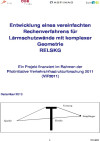RELSKG - Developement of a simplified method of calculations for noise protection walls with complex geometry
Short Description
Stating Point / Motivation
A standardised method for the calculation of the acoustic radiation is the ray tracing method. In its standard form, as used in sonic calculations, the sound level in shadowed regions cannot be estimated. Therefore, correction factors for the shadowed regions are implemented in the software for usual types of noise barriers. For complex cross sections of noise barriers such factors are missing.
Content and goal
The boundary element method is an approximately exact method for the calculation of the sound field behind such complex structures. The time required for computing is still very high. In the past the main applicant developed a two-dimensional boundary element method appropriate for the calculation of noise barriers.
Methods
In particular a model for grassland was implemented in a way that only the barrier had to be discretised, because the half space is part of the fundamental solution. The program allows the use arbitrary absorption coefficients and arbitrary geometry of the noise barrier. Tilted barriers and barriers with more than one reflection edge can be simulated.
The results of the simulation were validated by experiments. Former calculations showed considerable interference effects in the shadow region, therefore several positions of the sound source were tested.
Results and Conclusions
The comparison between the values obtained by measuring and by the use of the ray tracing method showed a satisfying conformity. After the experimental validation correction factors for the ray tracing method were derived and published. The correction factors obtained through calculation were implemented in the software package Sound Plan. The derived correction-functions are freely available and can thus easily be used in programme packages.
Publications
RELSKG - Developement of a simplified method of calculations for noise protection walls with complex geometry

The aim of the project was to determine correction factors for noise barriers with complex geometries to be used in the ray-tracing method based on numerical simulations with the boundary element method. The results of the simulations were validated by measurements. Complex geometries of the noise barriers included barriers with more than one refraction edge and curved geometry. The expected correction factors allow the implementation of the results in standard calculation software used in practice.
Dr. Holger Waubke, Dr. Christian Kasess, DI Heinz Hoislbauer, Ing. Gerhard Strohmayr, Dipl. Phys. Dieter Zollitsch
Publisher: BMVIT
German, 147 Seiten
Publication Downloads
Project Partners
Project manager
Dr. Holger Waubke - Austrian Academy of Sciences - Acoustics Research Institute
Project partners
- DI. Heinz Hoislbauer - TAS Sachverständigenbüro für Technische Akustik SV-GmbH
- Dipl. Phys. Dieter Zollitsch - Braunstein + Berndt GmbH
Contact Address
Austrian Academy of Sciences - Acoustics Research Institute
Dr. Holger Waubke
Tel.: +43 (1) 51581-2507
E-mail: holger.waubke@oeaw.ac.at
